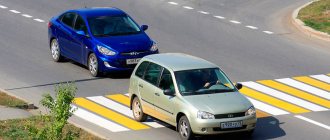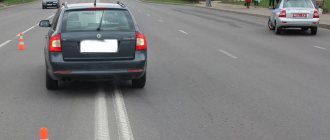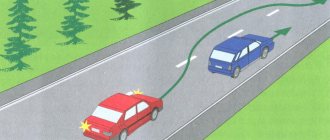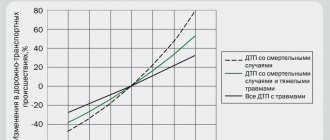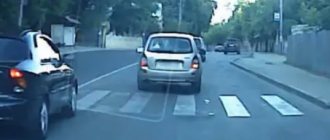Comments to clause 11.3 of the traffic rules
So, if you are being overtaken, you are prohibited from increasing your speed or otherwise preventing your car from being overtaken. What actions can be included in the word “other”? Most likely the following:
- cutting off an overtaking person,
- decreasing the lateral interval,
- logically, even sounding a beep or blinking high beam headlights can be formally subsumed under the term “preventing overtaking.”
Below you can see typical violations of clause 11.3 by car drivers.
Left turn
Is turning left an obstacle to overtaking? No. In general, the term “obstacle” has a definition, but “obstruction” does not, and logic suggests that these are different terms in essence.
In this matter, the trajectories of the vehicles intersect. So it's a matter of priorities. The obligation to give way is clearly stated in the traffic rules, and the overtaking person has such an obligation - clause 11.2 instructs him not to interfere (equally give way in the terminology of the traffic rules - clause 1.2) to the person being overtaken when returning to his passing lane. Does this mean that if you are overtaken, then you have priority in any case - even when turning left?
Of course not! It's very simple - when you turn left, you also have obligations to give way. And overtaking includes not only entering oncoming traffic and moving along it, but also returning to your lane.
Ultimately, the practice of analyzing the traffic police and judicial practice suggests that in such a controversial situation the one who later turned on the turn signal is to blame:
- if they started overtaking you when your turn signal was already on (you indicated your intention to turn left), then clause 11.2 of the traffic rules prohibited another car from overtaking,
- if you have already been overtaken and after that you turned on the left turn signal, then you are obliged to give way to the overtaking person, but only guided not by paragraph 11.3 of the Rules, which we are discussing, but according to paragraph 8.1, which prohibits starting any maneuvers if interference is created for other road users.
Another subtlety of 11.3 - an explanation of speed
It consists precisely in the prohibition of preventing overtaking by increasing speed. It would seem, what could be confusing here?! It’s quite possible when they started overtaking you almost immediately from the start after an intersection, for example, when your speed is literally 5-15 km/h, and you just started accelerating.
In this case, does clause 11.3 of the 2021 Traffic Regulations require you to stop accelerating and “puking” these same 5-15 km/h while waiting for the other vehicle to complete the overtaking maneuver? Yes, formally this is exactly what the Rules indicate.
Indeed, in fact, increasing the speed in this case prevents overtaking. However, this can also be debated for a long time, because the traffic rules do not define the term “obstruction.” If we understand it as a precedent - there was an obstacle to overtaking only if you disrupted this maneuver for the overtaking person, and he did not overtake you, then the event of this confusing term took place. If the overtaking man has completed the overtaking maneuver, then where does the obstacle come from - after all, we allowed him to complete what he started!
This controversial subtlety lies in paragraph 11.3 of the Traffic Rules!
Just a reminder of what overtaking is
Surprisingly, some motorists, and occasionally law enforcers, confuse overtaking and advancing. The first is the second, associated with driving into the oncoming lane. If there was no oncoming traffic, then this is not overtaking.
This also applies to situations where:
- a vehicle is ahead of another in the passing lane,
- You are driving slowly and decide to let the cars behind you pass by moving to the side of the road - if you are ahead of them without entering the oncoming lane, then this is also not overtaking.
This is overtaking, and paragraph 11.3 applies in this case
And this is an advance, and 11.3 does not affect it
Consequently, paragraph 11.3 of the traffic rules has a clear prescription only in the case of overtaking. It is not applicable in forward situations.
Overtaking: DANGER BY GOOD WILL or UNSURE DO NOT OVERTAKE
Overtaking is paradoxical. On the one hand, this is the most dangerous maneuver, during which approximately every fifth accident occurs, but at the same time, every third person killed out of 3,000 killed on the roads in Kazakhstan is killed as a result of a collision in the oncoming lane due to driver errors in performing the most dangerous maneuver - overtaking. on the other hand, we take risks voluntarily. After all, no one forces us to overtake a line of trucks rushing in the rain at high speed, for the sake of the dubious prospect of arriving home from work five minutes earlier... Let's start by repeating the Rules of the Road of the Republic of Kazakhstan, what is “OVERTAKING?” Overtaking is called “Ahead of one or more vehicles funds associated with leaving the occupied lane.” Since October 21, 2021, changes have been made to the traffic rules of the Republic of Kazakhstan and they again affected OVERTACKING. Now OVERTAKING is the process of getting ahead of one or more vehicles by leaving the occupied lane and then returning to the previously occupied lane. About driving with a minimum permitted distance was removed 2 years ago, now it is unclear how the term overtaking can be interpreted when driving in a dense traffic flow in one direction if the driver, for example, 20-30 meters from the vehicle moving in front, changed lanes into the adjacent lane, then into the adjacent lane with then the car overtook him at a higher speed. About 10 meters away I changed lanes to the right - this is most likely changing lanes and getting ahead, but it’s difficult to attribute this to overtaking. Everything is leading to the fact that the term overtaking will take on the meaning to which it is gradually approaching. That is, advancing and entering the oncoming lane. This is in the Rules of the Republic of Kazakhstan. In Russian traffic rules, overtaking is considered to be the advance of one or more vehicles, leaving to the side of the lane intended for oncoming traffic and then returning to the previously occupied lane. (side of the roadway)
And this makes sense, since we are talking about the most dangerous maneuver, and the main danger lies in wait for the driver in the oncoming lane.
I did not find any permitted overtaking on the RIGHT in the Russian Rules. At the beginning we say that overtaking is done on the left side, and then we begin to explain that there is also overtaking on the right? This is when the vehicle in front gave a signal to turn left and began to execute it, introduced! And what does it look like? It is correct to “Detour” a vehicle making a left turn or changing lanes, if the detour involves leaving a previously occupied lane.
OVERTAKING CAN BE WITH AND WITHOUT ENTRY INTO THE ONWARD TRAFFIC LANE - THIS IS IN THE TRAFFIC RULES OF THE RK. OVERTAKING A VEHICLE WHOSE DRIVER HAS SIGNALED A LEFT TURN AND HAS STARTED PERFORMING A MANEUVER IS CARRIED OUT FROM THE RIGHT SIDE,
But if the car is stationary, allowing oncoming traffic to pass, and the driver of the green car went around it on the right and did not return to the left lane - what will happen? BYPASS, or ADVANCE, but not OVERTAKING.
Overtaking traffic in the adjacent lane at a higher speed is not considered overtaking.
Such a maneuver is also considered ADVANCE.
You can read these elementary truths, which are taught in driving schools, in a traffic rules textbook. It would seem that it is not clear - follow the Rules, and you will get rid of troubles and troubles. But it turns out that not everything is so simple. If we exclude outright reckless drivers and hooligans who do not care about the provisions of the Rules and do not take into account other road users, the rest of the drivers find themselves in conflict situations that occurred due to the fact that they did not take something into account, did not think, and something simple, and they didn’t know. Because this comes with experience and is learned at the cost of mistakes, which are not always harmless, we want to talk about the subtleties that make overtaking quite SAFE.
It is generally accepted that overtaking is the most dangerous and difficult maneuver. Although in terms of chapter 1. In the definition of MANEUVERING, there is no overtaking. It is impossible to do without overtaking on the road. As statistics show, road accidents and the most terrible incidents on the road, which lead to serious consequences, death and injury to people, often occur only because of violations of the rules of overtaking by driving into the oncoming lane! All of our country roads, except Rudnenskaya, are narrow roads on which overtaking is carried out by entering the lane of oncoming traffic. Imagine for a second that all the roads suddenly became at least four lanes and oncoming traffic was separated by a steel fence, not like on the Rudny highway, where the dividing strip does not protect in any way from an oncoming car, but at least with such bollards with steel guides, they they will not save someone who wants to drive into oncoming traffic from a truck. But if a passenger car hits them at an acute angle, then such a fence may well prevent driving into the oncoming lane. In Moscow, they have already tested road fencing entirely made by Russian engineers. This fence withstood a bus that crashed into it at an angle of 20 degrees. If a bus can withstand it, then a passenger car can withstand it freely. The complexity and danger of overtaking lies in the fact that in a short time the driver has to calculate many factors and options that affect the safety of the maneuver. This includes control over the trajectory of your car, the speed and length of the overtaken vehicle, the distance and speed of oncoming vehicles, which is especially important! It is because of errors in determining the last factor that serious accidents occur.
When entering the oncoming lane, correctly assess the speed of oncoming traffic; the smaller its dimensions, the lower the speed appears. In addition, the speed of dark-colored cars is usually underestimated. At night and in conditions of insufficient visibility (for example, in fog), the speed of an oncoming vehicle is underestimated, and the distance to it appears greater than it actually is. Also, road bends, ascents and descents significantly reduce the accuracy of the assessment. Especially when overtaking trucks with a trailer, this is, firstly, their length and, accordingly, an increase in overtaking time, and we also need to take into account our national feature - this is the wobble of the trailer, and significantly, but more on that later. It is necessary to take into account that the speed of your and the oncoming car is added up: if you are moving at a speed of 80 km/h, and the oncoming car is at the same speed, then you and the oncoming vehicle are approaching each other at a speed of 160 km/h. This suggests that the approach occurs at a speed of 44.4 m/s, that is, a distance of 200 meters will be covered in less than 5 seconds.
Before you start overtaking, you need to decide for yourself - is it necessary to overtake in this particular situation? Overtaking is necessary to maintain the desired speed. However, it is advisable to overtake those vehicles that are moving at a speed lower than the speed of the traffic flow. In a city where traffic is regulated by traffic lights, overtaking has no benefit; on the contrary, each overtaking person creates emergency situations; moreover, the driver makes unnecessary gear changes, unnecessary braking, and creates unnecessary hassle for himself.
. Those drivers who drive into oncoming traffic on the 2-lane roads of Abay and Gagarin streets grossly violate the Rules. Al-Farabi. But this absolutely cannot be done. For driving into the oncoming lane (clause 9.2 of the RK traffic rules). Under Article 596-3. Code of Administrative Offences. RK year of deprivation of rights. The first sign of an unskilled driver is frequent unnecessary overtaking. We see. How does such a driver overtake everyone, sometimes making risky maneuvers, breaking the Rules, risking getting into an accident, and the end result! You catch up with him at the next intersection and stand together at the traffic light with a prohibitory signal. Then he starts again and the race is on again! And again you calmly approach him at the next intersection.
When returning to a previously occupied lane, many drivers violate the Rules and “cut off” law-abiding drivers who are forced to slow down and give way to reckless drivers overtaking them. Experiments have established that when overtaking “on the move,” the safe distance to the oncoming car is numerically equal to 9 times the speed of the vehicle being overtaken (40 km/h x 9 =360), and when overtaking while waiting, it is 10–11 times the speed (40 km/h x 10=440). When driving outside the city, the road should be visible at a distance of 500-700 meters, and in the city 300-460 meters . Driving school students, when the teacher explains the topic “OVERTAKING,” ask a simple question: “What should be the speed when overtaking?” In fact, it does not matter what the speed of the overtaking or being overtaken is, but the difference in speed between the overtaken and the overtaking vehicle is DECISIVE, i.e. How much faster are you driving than the vehicle you intend to overtake? This factor is decisive in determining the area required to complete the maneuver safely. The higher the difference in vehicle speeds, the shorter the distance and overtaking time, and vice versa. So, for example, if the speed of the overtaking vehicle is 30 km/h, and the overtaking vehicle is 60 km/h, (30). the overtaking distance is 192 meters. And the time is 13.7 seconds. At the same time, at a speed of 50 and 70 km/h (20), it will already be 455 and 19.5, that is, it will increase by more than 2 times.
Now let's move on to the nuts and bolts of overtaking.
Before overtaking, the driver must ensure that:
– The lane into which he intends to enter is clear at a distance sufficient for overtaking, and with this maneuver he does not interfere with oncoming vehicles or vehicles moving behind in the same lane (clauses 19.11 and 19.12 of the Road Rules of the Republic of Kazakhstan).
– The vehicle following behind in the same lane did not begin to overtake.
– The driver of a vehicle moving ahead in the same lane did not signal to turn left.
– Upon completion of overtaking and entering the lane (side) of oncoming traffic, he will be able, without interfering with the overtaken vehicle, to return to the previously occupied lane (one of the most common violations of the rules is the so-called cutting) .
— It is necessary to use rear-view mirrors in the cabin and side mirrors, and be sure to look out the driver’s side window, not forgetting about the “maneuvers” of visibility zones when a car located at a threatening close distance is not visible through the rear-view mirrors.
— Make sure that the driver of the overtaken car will not change lanes, that is, you need to look and calculate whether there are intersections or exits from the road ahead that the overtaken driver can turn onto. These options often help avoid accidents.
On western highways, truck drivers walking in a convoy, seeing that the driver of a car trying to overtake, doubts whether they see him. Drivers of road monsters try to help their smaller brothers - drivers of cars; for this, the truck driver turns on the right turn indicator and moves to the right, and all other trucks duplicate this maneuver. I myself found myself in such situations and was very surprised by such politeness when drivers of such large cars let you through. This is not accepted here, on the contrary, KAMAZ drivers drive in the middle of the roadway, look in the mirror and smile - they say, go for it, overtake if you can. You need to choose the moment when the dangling trailer moves to the right, and at that moment try to pass and not get under the trailer of the car you are overtaking. Moreover, looking at the road so as not to fall into a hole is not for the faint of heart.
A very important point is the final phase of overtaking, the main rule of which is not to interfere with the overtaken vehicle and not to force it to brake sharply or turn to the side. I remember an incident that happened on the Fedorovka-Kostanay highway, when the driver of a Zhiguli started overtaking an Ikarus without judging the distance to the oncoming car. And to avoid a head-on collision, he literally dived under the Ikarus, cutting it off. The driver of the Ikarus, in order to avoid hitting the Zhiguli, slowed down on a slippery road, he was carried out onto the washed out side of the road, the bus went into a ditch and overturned, six people died - this is the tragic end of overtaking and the wrong actions of the Zhiguli driver.
And now about the mutual courtesy of drivers involved in overtaking. By turning on the left turn signal, you warn those driving behind you. The driver of the car being overtaken must be warned with headlights and outside the city with a sound signal. If he then turned on the left turn signal, then perhaps he sees a danger ahead, about which he is sending you a warning. In this case, refuse to overtake. Overtaking needs to be done quickly, so you need to move with acceleration, and create a speed advantage of at least 15-20 km/h than the person being overtaken. It is precisely in these conditions that the advantage of cars with a powerful engine of 2 liters or more is felt, and these are, as a rule, foreign cars. They are dynamic and allow drivers to overtake painlessly, easily responding to the gas pedal. But on less powerful cars you need to switch to a lower gear. Try not to linger in the invisible of the driver being overtaken; maintain a gap of at least the width of your vehicle, especially if the vehicle being overtaken has a trailer. Do not move for a long time in parallel rows with him. If a long truck or bus overtakes you and overtakes you slowly, then you either move ahead of him or slow down, making his task easier, but do not move in parallel - this is fraught with consequences . And - attention! If you have doubts about the success of overtaking, return to your original place. You can start changing lanes only when both headlights of the vehicle being overtaken are visible in the rearview mirror. You need to change lanes smoothly, without reducing speed or braking.
Using “flashing” when overtaking : turn on the left turn signal when leaving the occupied lane, then turn it off when ahead; turn on the right indicator when returning to your lane. Many people do not turn off the left turn signal during the entire overtaking, thereby misleading drivers of oncoming cars.
What mistakes are most common for novice drivers?
- Overtaking is too extended due to the small difference in the speeds of the overtaking and overtaken cars, or they do not take into account the fact that overtaking a long vehicle (road train, bus) requires 5 times more free road than when overtaking ordinary cars.
- Too long observation when inspecting the situation from the side and behind before overtaking. This leads to the fact that unexpected changes in the situation ahead go unnoticed, and the car may deviate from the correct trajectory. Before overtaking, you need to inspect the situation carefully, but quickly.
- Early and abrupt termination of overtaking due to incorrect estimation of speed driving or making a sharp turn without traveling a sufficient safe distance. You can complete overtaking only by getting ahead of the overtaken vehicle at a sufficiently large distance.
- Complete absorption in your actions while driving to the detriment of monitoring the situation ahead. The road situation must be monitored throughout the maneuver.
If they overtake you. What should you do?
- Observe the situation ahead and, if danger arises, warn the overtaking person by turning on the left turn signal several times.
- If necessary, reduce your speed by turning on the right turn signal, which means that you see an overtaking vehicle and give way to it. Move to the right, and the driver overtaking you will finish passing faster. Another time you will find yourself in the place of the overtaking one.
- Before making a maneuver, give your turn signal in advance, at least 5 seconds before the maneuver.
- Do everything possible to avoid becoming involved in a traffic accident.
If overtaking is done at night, the headlights shining through the rearview mirror can blind the driver in front, so it is necessary to switch the high beam headlights to low beam in advance as soon as you are sure that the signal to overtake has been received. Turn on the high beams again when the vehicles are level with each other. We have already said that at night you need to avoid overtaking at speeds above 90 km/h , because the stopping distance exceeds the visibility of the road.
In rainy, slushy weather, it is not recommended to drive close to the car you are overtaking, as water and dirt flying out from under the wheels contaminate the windshield and impair visibility. In this case, the distance must be increased. The actions of overtaken vehicles are very important. They are prohibited from preventing overtaking by exceeding the speed limit, entering the overtaking lane, or performing any other actions.
A disciplined, competent driver, making sure that his vehicle is being overtaken, gives a hand signal, a right turn signal, that he sees and gives way to the overtaking person. If the driver of the car being overtaken sees obstacles ahead that interfere with overtaking, he must show with a gesture that overtaking is dangerous, but should not interfere with overtaking. Such mutual observance by drivers of overtaking rules creates a safe environment on the road.
Due to the difficulty and danger of overtaking, overtaking is prohibited in certain places and conditions:
OVERTAKING IS PROHIBITED AT UNCONTROLLED INTERSECTIONS ON NON-MAIN ROADS.
AT PEDESTRIAN CROSSINGS IF THERE ARE PEDESTRIANS ON THEM.
AT RAILWAY CROSSINGS AND CLOSE TO 100 meters IN FRONT OF THEM.
OF A VEHICLE PERFORMING OVERTAKING OR DETAILING (DOUBLE OVERTAKING).
AT THE END OF THE RISE
NEAR DANGEROUS ROAD CURVES and ON OTHER ROAD AREAS WITH LIMITED VISIBILITY ENTERING THE SIDE OF ONWARD TRAFFIC.
AT CONTROLLED INTERSECTIONS WITH ENTRANCE TO THE LANE (SIDE) OF ONWARD TRAFFIC.
IT IS PROHIBITED TO DRIVE (OVERTAKE) INTO THE LEFT LEFT LANE ON TWO-WAY TRAFFIC ROADS WITH THREE LANES. POINT-9.3. Traffic rules of the Republic of Kazakhstan.
IT IS PROHIBITED TO OVERTAKE (EXIT) THROUGH THE DOUBLE SOLID LINE 1.3.
ON ROADS WITH 4 (FOUR) OR MORE LANES FOR TRAFFIC IN BOTH DIRECTIONS. ACCORDING TO THE NEW Code of Administrative Offenses of the Republic of Kazakhstan, such a violation is subject to deprivation of rights for six months
AT UNregulated intersections of equal roads.
I would like to emphasize that the largest number of accidents outside the city when overtaking occur at the end of the climb, i.e. closer to the top, with driving into oncoming traffic. In addition to the climb, participants with limited visibility are turns where visibility is less than 100 meters. So, in such areas, overtaking is strictly prohibited, because you are entering the oncoming lane, and the drivers of oncoming cars do not see you, and in this situation it is quite difficult to avoid an accident, especially if the oncoming car is a truck. Road signs also inform us about the prohibition of overtaking; if they have a sign, then it indicates the prohibition zone, and if without a sign, then the sign is valid until the next intersection or until the end or beginning of the populated area, the specified point, indicated by a sign on a white background.
ATTENTION! In the Russian Federation, overtaking is prohibited: on BRIDGES, overpasses, overpasses and under them. And also in tunnels. Don’t forget in the Russian Federation, overtaking is when you enter the oncoming lane. In the Republic of Kazakhstan, on all bridges there is a double solid line - 1.3, or a single line - 1.1. Which you also can’t cross. In tunnels, oncoming traffic is usually separated by a “ bumper”
You cannot overtake through solid marking lines, especially double solid markings - 1.3. And if there are two lines - solid and broken, 1.11, then you can overtake from the side of the broken line, and if you entered the lane of oncoming traffic, then you need to return to the previously occupied lane. Why am I telling you in such detail - I just want drivers, or students who are preparing to become drivers, after reading this article, to refresh their memory of this one of the most important sections of the Rules. And “Azov” of road safety, I have seen many accidents that occurred due to violations of overtaking rules. When a passenger car drives into the oncoming lane and is driven off the road by a truck. From the impact of the Mercedes, which was overtaking at a speed of 200 km/h and did not have time to take its starting position, which is not surprising at such a speed, the truck rolled back 20 meters. Or motorcyclists, hitting a ZIL 130 in an Izha, tore the engine off its mounts, and the bodies of the motorcyclists smashed the cabin and injured the driver. You need to know this, imagine and always remember that a car is not only a means of comfortable transportation, but in inept hands, if the Rules are violated, it is a formidable weapon for others, for all road users. Be safe
CONSIDERING THE COPICALITY OF THIS TOPIC FOR MOTORISTS, WE DECIDED TO DEVOTE ONE OF SECTIONS 7 OF THE TRANSMISSION TO “ALAU” WHICH WILL BE HELD ON FRIDAY, November 18, 2016 at 20.30.
So be healthy and safe and good luck on your journey.
14, total, today
Also interesting for you!
Car and environment
Ring roads
Speed and distance in figures and facts
Tips for women driving.
The law came into force. Medical commission for driving school students according to the new rules. DVR...
The 2021 training season for motorized vehicles has already begun.
← Previous post
Next entry →
Leave a comment Cancel reply
Important note!
- This article provides basic information, but each case is different.
- In 92% of all situations there are important nuances that can affect the outcome of the entire case.
- An experienced lawyer will study all the materials of the case and indicate in which direction to move.
Therefore, our website employs on-duty legal consultants who delve into each case and are aimed at solving it.
Ask a Question
or consult toll-free (Moscow), (St. Petersburg), 8 (all of Russia).
Fine for violating clause 11.3 of traffic rules
There is no one for 2021. There is no structure to charge a driver for violating 11.3 of the Rules - this means that there is no corresponding article of the Code of Administrative Offenses that would provide for punishment for obstructing overtaking.
The closest article - 12.15 of the Administrative Code - provides penalties only for the overtaking vehicle, as well as for slow-moving vehicles that do not allow vehicles following them to pass. But there is not a word about preventing overtaking.
Another norm - Part 3 of Article 12.14 provides for a penalty of 500 rubles for failure to comply with the traffic rules requirement not to create interference in all cases, except for driving through intersections. It is this norm that is most often used by cunning traffic police officers in an attempt to issue a fine. But it is inappropriate here for the simple reason that it provides sanctions specifically for creating interference, and in our paragraph 11.3 the requirement is stated not to interfere, and not not to create interference, and these are different things according to the letter of the law.
However, this does not mean that you can violate 11.3 whenever you want. Nobody canceled the blame for the accident. In this case, if an accident occurs, for example, because you increased your speed when you were being overtaken, which is why the overtaking person did not have time to move into his passing lane, then a ruling will be issued against you to refuse to initiate a case. But the fault will be yours. Moreover, a collision with oncoming traffic is a very dangerous accident, and the Code of Administrative Offenses for the perpetrator of this provides for another article - 12.24, which provides for deprivation of rights, and sometimes it is possible to be charged under a criminal article (in case of death due to negligence).
Special rules for prohibiting overtaking: clause 11.4 of the traffic rules
The creators of the Russian Traffic Regulations, caring for the safety of road users, do not particularly rely on the consciousness of Russian drivers, who will be able to soberly assess the danger of the proposed overtaking. And therefore, a special paragraph of Section 11 of the Rules is devoted to listing sections of roads on which it is strictly forbidden to perform this maneuver. Let's look at each of these principles.
Overtaking is prohibited at signalized intersections
Let's ask ourselves: Why is overtaking not allowed at a controlled intersection?
The answer is elementary and simple. The very fact of the presence of a controlled intersection means that at this intersection of roadways the intensity of vehicle traffic in all directions is quite high. And the regulatory mechanism (in the form of a traffic light or a traffic controller) is organized here to create a normal, effective sequence of passage from all directions. This sequence will make it possible to eliminate long-term idleness of vehicles on some routes (as is quite possible when organizing traffic using priority signs or without them at all).
Consequently, when a traffic light (or corresponding signal from a traffic controller) is turned on (sent), the probability of vehicles moving in the oncoming lane is very high. This is the essence of signalized intersections. Therefore, overtaking at such intersections will involve a real possibility of creating interference for vehicles moving in the oncoming lane.
Overtaking is prohibited at uncontrolled intersections when driving not on the main road
Let's try to understand this requirement from the inside out. That is, overtaking is allowed at an uncontrolled intersection when the driver enters it on the main road.
This permission is completely justified. After all, a driver moving through an intersection on the main road has an advantage over those motorists who enter it from secondary directions and must give way. Therefore, overtaking at such an intersection (while driving on the main road) is relatively safe.
But if a driver enters an intersection on a secondary road, then, in addition to observing the rules of safe overtaking, he must also take care to give way to vehicles that have priority at the intersection.
This position contributes to the driver's attention dispersion and can lead to an accident or an emergency situation at an intersection. Therefore, a driver located at a secondary entrance to an intersection must refrain from plans to overtake in the intersection area.
True, if he wants to overtake before the intersection, then this is not prohibited (unless other traffic rules are violated, and if the overtaking is completed before the intersection).
The ban on overtaking applies precisely at such an intersection, but does not apply to the section of the road immediately following the intersection of roadways.
Overtaking is prohibited at pedestrian crossings
The ban on overtaking at pedestrian crossings (both regulated and unregulated) should not cause criticism. All this is done to ensure the safety of pedestrians.
The motivation of the creators of traffic rules prohibiting overtaking at any pedestrian crossing is clear and obvious. A driver intending to make such a dangerous maneuver must be aware of the situation at the pedestrian crossing. However, when overtaking a vehicle here, he inevitably encounters a “dead zone” at the crossing. Its visibility is severely limited by the vehicle being overtaken.
And a pedestrian who at such a moment intends to cross the roadway will be practically doomed. How sad is this...
Overtaking is prohibited at railway crossings and 100 meters before them
The ban on overtaking here is due to the potential danger of the railway crossing itself. This is a very inconvenient section of the road even for normal traffic: drivers have to move at a snail's pace across the rails so as not to damage the suspension, wheels and even the power unit of their car.
The peculiarity of crossing railway crossings is also due to a number of prohibitions introduced by the Rules when making a U-turn, reversing, stopping and parking here. And - of course - overtaking.
But why can’t you overtake 100 meters before a railway crossing?
It's simple. When overtaking on such a section of the road, there is a high probability that the driver will interfere with oncoming vehicles that are leaving the crossing. And this is a direct road to traffic jams at the railway crossing, creating a monstrous danger for traffic. What if there is a train?
But after passing the railway tracks, the restriction on overtaking is lifted (unless, of course, some other overtaking prohibitions begin to apply). For example, a solid marking line.
As numerous practice shows, when organizing traffic before and after a railway crossing on the roadway, you can most often observe a “single continuous” line of horizontal road markings. Therefore, even after passing a railway crossing, the driver must show maximum attention so as not to violate the rules of overtaking.
Overtaking is prohibited on bridges, overpasses, overpasses and under them
Artificial structures are inherently dangerous sections of the road where a number of maneuvers are limited (turning, reversing, partially stopping and parking). Therefore, it is not surprising that overtaking is prohibited on them.
The ban on overtaking on bridges, overpasses, overpasses and under them is due to limited space. And in the event of an emergency and the need for a sudden oncoming pass, it will simply be impossible for drivers to maneuver.
Overtaking is prohibited in tunnels
The ban on overtaking in tunnels is due to the same limited space as in the previous case.
If the need arises to avoid a collision, drivers simply have no chance in a tunnel.
Overtaking is prohibited in areas with limited visibility
Overtaking on dangerous curves, at the very end of a hill, and in other areas where visibility is limited is extremely dangerous.
In such conditions, a driver who intends to overtake does not have all the information about the safety of the maneuver; that is why the Rules strictly prohibit its implementation.
Arbitrage practice
- Decision No. 12-37/2013 of the district court in Bashkortostan left the driver’s complaint that he was illegally charged under Article 12.14 of the Code of Administrative Offenses for violating clause 11.3. And violation 11.3 was charged for turning left when another car was overtaking it. However, the court dismissed the complaint.
- Decision No. 2-1/2015 of the city court of the Samara region that turning left does not constitute an offense in paragraph 11.3 of the traffic rules, that is, turning left is not an obstacle to overtaking, and other paragraphs of the Rules apply.



